Epson PowerLite Pro Cinema 31000, PowerLite Pro Cinema 61000 User Manual
PowerLite® Pro Cinema 31000/61000
Home Theater Projector
User’s Guide

Copyright Notice
All rights reserved. No part of this publication may be reproduced, stored in a retrieval system, or transmitted in any form or by any means, electronic, mechanical, photocopying, recording, or otherwise, without the prior written permission of Seiko Epson Corporation. The information contained herein is designed only for use with this Epson product. Epson is not responsible for any use of this information as applied to other products.
Neither Seiko Epson Corporation nor its affiliates shall be liable to the purchaser of this product or third parties for damages, losses, costs, or expenses incurred by purchaser or third parties as a result of: accident, misuse, or abuse of this product or unauthorized modifications, repairs, or alterations to this product, or (excluding the U.S.) failure to strictly comply with Seiko Epson Corporation’s operating and maintenance instructions.
Seiko Epson Corporation shall not be liable for any damages or problems arising from the use of any options or any consumable products other than those designated as Original Epson Products or Epson Approved Products by Seiko Epson Corporation.
Trademarks
Epson is a registered trademark, 1080Perfect and C2Fine are trademarks, and Epson Exceed Your Vision is a registered logomark of Seiko Epson Corporation.
PowerLite and PrivateLine are registered trademarks, DigiScan and AccuCinema are trademarks, and Extra Care and Epson Connection are service marks of Epson America, Inc.
AMX, the AMX logo, and Device Discovery are registered trademarks of AMX.
Crestron and the Crestron logo are registered trademarks of Crestron Electronics, Inc.
HDMI, the HDMI logo, and High-Definition Multimedia Interface are registered trademarks of HDMI Licensing, LLC.
Pixelworks, DNX, and the DNX logo are trademarks of Pixelworks, Inc.
THX and the THX logo are trademarks of THX Ltd. which may be registered in some jurisdictions. All rights reserved.
x.v.Color is a trademark of Sony Corporation.
General Notice: Other product names used herein are for identification purposes only and may be trademarks of their respective owners. Epson disclaims any and all rights in those marks.
This information is subject to change without notice.
© 2010 Epson America, Inc. |
8/10 |
|
CPD-28058 |
2
Contents
Introduction |
6 |
Projector Parts |
7 |
Remote Control |
9 |
Optional Accessories |
10 |
Registration and Warranty |
10 |
Using This Manual |
11 |
Setting Up the Projector |
12 |
Choosing a Location |
12 |
Installing the Projector |
16 |
Connecting the Cables |
18 |
Connecting Video and Computer Equipment |
18 |
Making Other Connections |
19 |
Installing Batteries in the Remote Control |
20 |
Turning the Projector On and Off |
21 |
Turning On the Projector |
21 |
Turning Off the Projector |
22 |
Selecting the Image Source |
22 |
Positioning the Image |
23 |
Making Basic Adjustments |
25 |
Focusing and Zooming |
25 |
Choosing the Aspect Ratio |
26 |
Choosing the Color Mode |
27 |
Advanced Color Adjustments |
27 |
Adjusting the Gamma Setting |
28 |
Adjusting RGBCMY |
29 |
Locking the Projector |
29 |
Contents 3
Making Detailed Adjustments |
31 |
Using the Menu System |
31 |
Changing How the Menus Display |
32 |
Adjusting the Picture Quality |
32 |
Input Brightness Settings |
33 |
Sharpness and Picture Quality Settings |
34 |
Color Settings |
36 |
Adjustments for Computer Images |
39 |
Selecting Memory Settings and Resetting the Projector |
39 |
Selecting Memory Settings |
40 |
Creating Memory Settings |
40 |
Renaming Memory Settings |
40 |
Deleting Saved Memory Settings |
41 |
Resetting the Projector |
41 |
Customizing Projector Features |
42 |
Image Sizing |
42 |
Screen Options |
43 |
Other Setup Options |
44 |
Making Network Settings |
46 |
Using HDMI Link |
48 |
Setting Up HDMI Link |
48 |
Using HDMI Link |
49 |
Using the Projector on a Network |
50 |
Connecting the Projector to Your Network |
50 |
Monitoring the Projector with a Web Browser |
51 |
Setting Up E-mail Alerts |
51 |
Receiving E-mail Alerts |
52 |
Maintenance |
53 |
Cleaning the Lens |
53 |
Cleaning the Projector Case |
54 |
4 Contents
Cleaning and Replacing the Air Filter |
54 |
Replacing the Lamp |
56 |
Resetting the Lamp Usage Timer |
59 |
Checking the Projector Status |
59 |
Storing the Projector |
60 |
Transporting the Projector |
60 |
Problem Solving |
61 |
What To Do When the Lights Come On or Flash |
61 |
Solving Picture Problems |
63 |
Solving Remote Control Problems |
66 |
Solving Other Problems |
67 |
Where to Get Help |
67 |
Specifications |
69 |
General |
69 |
Lamp |
69 |
Remote Control |
69 |
Dimensions |
70 |
Electrical |
70 |
Environmental |
70 |
Safety |
71 |
Compatible Video Formats |
71 |
ESC/VP21 Command Codes |
74 |
Notices |
75 |
Important Safety Information |
75 |
FCC Compliance Statement |
77 |
Declaration of Conformity |
78 |
Epson America, Inc. Limited Warranty |
79 |
Index |
81 |
Contents 5
Introduction
The PowerLite® Pro Cinema 31000/61000 projector lets you enjoy theater-quality images in the relaxing environment of your own home. Designed especially for home cinema use, it offers these outstanding features:
■Native 1080p (1920 × 1080) resolution, dynamic contrast ratio up to 1000000:1 (500000:1 for the Pro Cinema 31000), and up to 1200 lumens of brightness (white light output and color light output) for incredibly rich, sharp images in any room lighting
■Auto Iris system that constantly controls the light output based on the gamma and black/white levels of your projected content, for perfectly adjusted images and deepest blacks
■Epson® C2Fine™ 3LCD technology for reliable picture quality, increased contrast ratio and uniform colors
■1080Perfect™ video processing using HQV® Reon-VX technology for more film-like images free of noise or artifacts
■10-bit with partial 12-bit color quality for unmatched color accuracy, with over a billion colors available
■Epson AccuCinema™ color management delivered by the built-in optical Cinema Filter blocks out excess light for an expanded, purer color range and sophisticated grayscale tracking
■HDMI™ (High Definition Multimedia Interface™) port for superior, uncompressed digital video
■True 16:9 wide-format projection
■Flexible setup configurations, including front projection and ceiling mounted, with vertical and horizontal offset lens shift
■Five color modes, including x.v.Color™, to quickly optimize viewing for different lighting environments, and a vast array of custom color adjustments
6 Introduction
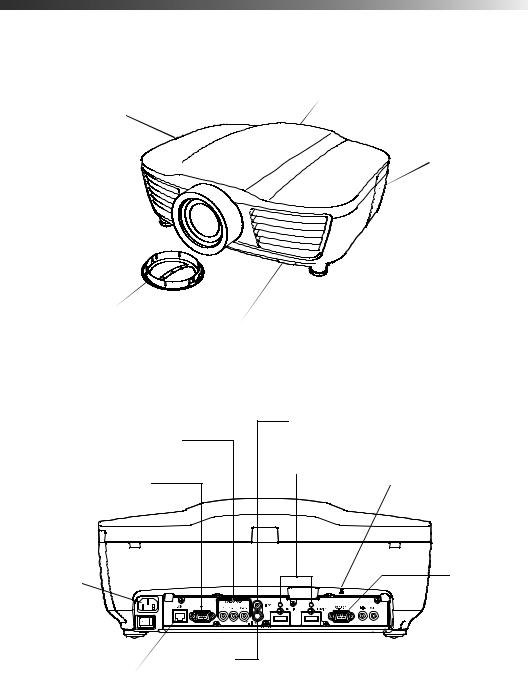
Projector Parts
Front
Infrared receiver (rear)
Control panel (side) 
 Lamp cover
Lamp cover
Ventilation slots 
(intake) 
 Ventilation slots (exhaust)
Ventilation slots (exhaust)
Lens cover |
Adjustable foot |
|
Infrared receiver |
||
|
||
(front) |
|
|
Back |
|
|
Video port |
||
Component video port |
|
|
Cable holders |
Kensington® |
|
PC port |
lock port |
|
|
||
AC power inlet |
Control port |
|
(RS-232C) |
||
|
||
Main power switch 
S-Video port
LAN port
(Pro Cinema 61000 only)
|
|
|
|
|
Trigger out ports |
|
|
|
|
|
|
|
|
|
|
|
|
|
|
|
|
|
(second port on Pro |
HDMI ports |
|
Cinema 61000 only) |
|||
Introduction 7

Bottom
Air filter cover release 
Mounting bracket attachment points
Optional cable cover attachment points
Projector Control Panel
Power  button
button
Menu button Displays the menus
Lens button  Adjusts focus,
Adjusts focus,
zoom, and lens shift
 Status lights (see page 61)
Status lights (see page 61)
Source button Switches the video input source
Esc button  Exits the current
Exits the current
menu item
 Enter button
Enter button
Selects menu items or opens the line menu
Menu navigation buttons
8 Introduction
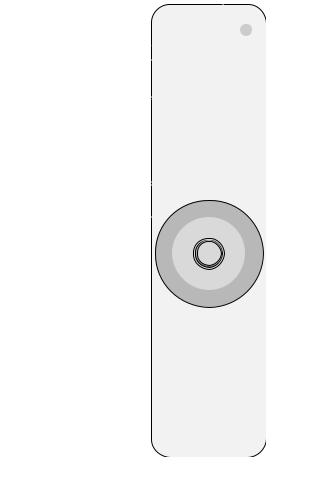
Remote Control
Power buttons
Turn projector on or off
Lens Shift button
Moves image up/down/left/right
Zoom button
Adjusts the image size
Focus button
Sharpens the image
Default button |
Restores default settings |
when menu is displayed |
Illumination button Lights the remote control buttons for easy viewing
Source buttons
Switch between equipment connected to the projector
HDMI Link buttons
Let you operate HDMI CEC compatible devices
 Menu navigation buttons
Menu navigation buttons
 Enter button
Enter button
Selects menu items or opens the line menu
Esc (escape) button
Exits the current menu item
 Menu button
Menu button
Displays the projector’s menus
Memory button |
RGBCMY button |
Color Mode button |
Recalls custom picture |
Adjusts the hue, saturation, and |
Optimizes viewing for |
settings |
brightness for each color |
different lighting environments |
Lens Iris button |
Super-res button |
Frame Int (interpolation) button |
Adjusts the amount of light |
Sharpens blurred edges of |
Smooths motion in rapid |
passing through the lens |
upscaled images |
pictures |
Aspect button |
Pattern button |
Blank button |
Changes the picture’s aspect |
Displays test patterns to adjust |
Temporarily stops projection or |
ratio |
the image |
hides the menu screen |
Introduction 9

Optional Accessories
Epson provides the following optional accessories for the projector:
Product |
Part number |
|
|
Replacement lamp |
V13H010L66 |
|
|
Air filter replacement |
V13H134A28 |
|
|
Kensington security lock (anti-theft device) |
ELPSL01 |
|
|
Cable cover |
V12H003005 |
|
|
Projector mount |
ELPHB800 |
|
|
Panamorph™ Fixed Anamorphic Lens Kit |
ELPFALK |
|
|
Panamorph Movable Anamorphic Lens Kit |
ELPALK2 |
|
|
In addition to the accessories listed above, 1-year and 2-year extended service plans are available. You can purchase these plans and other accessories from an authorized Epson reseller. To find the nearest reseller, please call 800-GO-EPSON (800-463-7766). To purchase online, visit www.epsonstore.com (U.S. sales) or www.epson.ca (Canadian sales).
Registration and Warranty
Your projector comes with a basic three-year carry-in warranty. For details, see page 79.
In addition, Epson offers free Extra CareSM Home Service. In the unlikely event of an equipment failure, you won’t have to wait for your unit to be repaired. Instead, Epson will ship you a replacement unit anywhere in the United States, Canada, or Puerto Rico. See your
Extra Care Home Service brochure for details.
To register, simply follow the registration instructions on the CD, or register online at www.epson.com/webreg. Registering also lets you receive special updates on new accessories, products, and service.
10 Introduction

Using This Manual
This book contains all the information you need to use the projector, in addition to basic setup and maintenance instructions, troubleshooting tips, important safety instructions, specifications, and warranty information.
Please follow these guidelines as you read through the manual:
Warning: Must be followed carefully to avoid bodily injury.
Caution: Must be observed to avoid damage to your equipment.
Note: Contains important information about your projector.
Tip: Contains helpful projection tips.
Need additional help? Take advantage of Epson’s automated support services 24 hours a day at www.epson.com/support (U.S.) or epson.ca/support (Canada). Use this site to view FAQs (Frequently Asked Questions) or product information and e-mail your questions to Epson support.
If you need more help, you can use the Epson PrivateLine® Support service. Call
(800) 637-7661 and enter the PIN on the PrivateLine support card that came with your projector.
Introduction 11

Setting Up the Projector
Follow the instructions in this section to choose a location for the projector, connect the cables, and display an image.
Choosing a Location
You can install the projector for the viewing setups shown below, as well as rear projection.
Center |
|
|
|
|
|
Side |
|
|
|||||
|
|
|
|
|
|
|
|
|
|
|
|
|
|
|
|
|
|
|
|
|
|
|
|
|
|
|
|
Ceiling
12 Setting Up the Projector

Ideally, keep the projector level and place it at a height so its lens is centered between the top and bottom of the screen, as shown below. If this is not possible, use the lens shift function to reposition the image (see page 23). As a rule of thumb, you can use lens shift to move the image up or down by nearly its full height, and left or right by about one-half its width (for details, see page 24).
|
|
|
Offset A |
|
|
|
|
|
|
|
|
|
|
|
Offset B |
|
|
|
|
|
|
|
|
|
|
|
|
|
|
|
Offset refers to distance from |
|
|
|
|
|
|
|
|
|
|
|
bottom of image to center of |
Projection distance |
|
|
lens using maximum lens shift. |
If you place the projector off to the side, aim it straight ahead (rather than at the center of the screen), then use the horizontal lens shift to center the image on the screen.
Caution: Do not try to move the lens by hand, or you may damage the projector. Always use the lens shift function to change the lens position.
Setting Up the Projector 13
The size of the image is determined by the distance from the projector’s lens to the screen. Depending on your display settings, the actual size may differ. Use these tables as a guide for projector placement:
16:9 aspect ratio
|
Diagonal image size |
|
|
Projection distance |
(width × height) |
Offset A |
Offset B |
|
|
|
|
2.7 to 5.9 feet |
30 in. (26 × 15 in.) |
5.1 in. |
20.6 in. |
0.83 to 1.79 m |
76.2 cm (66 × 37 cm) |
13 cm |
52 cm |
|
|
|
|
3.6 to 7.9 feet |
40 in. (35 × 20 in.) |
7.8 in. |
27.5 in. |
1.11 to 2.40 m |
101.6 cm (89 × 50 cm) |
20 cm |
70 cm |
|
|
|
|
5.5 to 11.8 feet |
60 in. (51 × 28 in.) |
11.8 in. |
41.2 in. |
1.69 to 3.61 m |
152.4 cm (130 × 75 cm) |
30 cm |
105 cm |
|
|
|
|
7.4 to 15.8 feet |
80 in. (71 × 39 in.) |
15.7 in. |
54.9 in. |
2.26 to 4.82 m |
203.2 cm (180 × 100 cm) |
40 cm |
139 cm |
|
|
|
|
9.3 to 19.8 feet |
100 in. (87 × 47 in.) |
19.6 in. |
68.6 in. |
2.83 to 6.04 m |
254 cm (220 × 120 cm) |
50 cm |
174 cm |
|
|
|
|
11.2 to 23.8 feet |
120 in. (106 × 59 in.) |
24 in. |
82 in. |
3.41 to 7.25 m |
305 cm (270 × 150 cm) |
60 cm |
209 cm |
|
|
|
|
14.0 to 29.8 feet |
150 in. (130 × 75 in.) |
29 in. |
103 in. |
4.27 to 9.08 m |
381 cm (330 × 190 cm) |
75 cm |
262 cm |
|
|
|
|
18.7 to 39.7 feet |
200 in. (173 × 98 in.) |
39 in. |
137 in. |
5.70 to 12.11 m |
508 cm (440 × 249 cm) |
87 cm |
336 cm |
|
|
|
|
4:3 aspect ratio
|
Diagonal image size |
|
|
Projection distance |
(width × height) |
Offset A |
Offset B |
|
|
|
|
3.3 to 7.2 feet |
30 in. (24 × 18 in.) |
7.2 in. |
25.2 in. |
1.02 to 2.20 m |
76.2 cm (61 × 46 cm) |
18 cm |
64 cm |
|
|
|
|
4.5 to 9.6 feet |
40 in. (32 × 24 in.) |
9.6 in. |
33.6 in. |
1.37 to 2.94 m |
101.6 cm (81 × 61 cm) |
24 cm |
85 cm |
|
|
|
|
6.8 to 14.5 feet |
60 in. (47 × 35 in.) |
14.4 in. |
50.4 in. |
2.07 to 4.43 m |
152.4 cm (120 × 90 cm) |
37 cm |
128 cm |
|
|
|
|
7.4 to 19.4 feet |
80 in. (63 × 47 in.) |
19.2 in. |
67.2 in. |
2.27 to 5.91 m |
203.2 cm (160 × 120 cm) |
49 cm |
171 cm |
|
|
|
|
11.4 to 24.3 feet |
100 in. (79 × 59 in.) |
24 in. |
84 in. |
3.48 to 7.40 m |
254 cm (200 × 150 cm) |
61 cm |
213 cm |
|
|
|
|
14 Setting Up the Projector
4:3 aspect ratio
|
Diagonal image size |
|
|
Projection distance |
(width × height) |
Offset A |
Offset B |
|
|
|
|
13.7 to 29.2 feet |
120 in. (94 × 71 in.) |
29 in. |
101 in. |
4.18 to 8.89 m |
305 cm (240 × 180 cm) |
73 cm |
256 cm |
|
|
|
|
17.2 to 36.5 feet |
150 in. (118 × 91 in.) |
36 in. |
126 in. |
5.23 to 11.12 m |
381 cm (300 × 230 cm) |
91 cm |
320 cm |
|
|
|
|
22.9 to 48.7 feet |
200 in. (161 × 118 in.) |
48 in. |
168 in. |
6.99 to 14.83 m |
508 cm (410 × 300 cm) |
122 cm |
427 cm |
|
|
|
|
To determine the exact image size when you know the projection distance (or the exact projection distance when you know the desired image size), you can use the Image Size Calculator. This program is available on the Epson website at epson.com/support (U.S.) or epson.ca/support (Canada).
Also keep these considerations in mind:
■Make sure there is plenty of space for ventilation around the projector. Air coming out of the ventilation slots can be quite hot. Do not place anything near the slots that can be damaged by heat.
■Make sure the projector is within 9.8 feet (3 m) of a grounded electrical outlet or extension cord.
Setting Up the Projector 15

Installing the Projector
To install the projector, you first need to determine the location, based on the size of your screen (maximum diagonal image size). Use the tables on page 14 as a guide to positioning the projector.
To suspend the projector from a ceiling, you will need the optional projector mount designed for the projector. See page 10 for ordering information. Follow the instructions included with the mount to install the projector.
Warning: When installing or adjusting the ceiling mount, do not use adhesives to prevent the screws from loosening and do not use any type of oil or lubricant. These may cause the projector casing to crack and the projector may fall, causing serious injury and serious damage to the projector.
If you install the projector on the ceiling, you will need to invert the picture so that it appears right side up. Follow these steps:
1.Press the Menu button on the remote control.
2.Open the Settings menu, then select Projection.
3.Select Front/Ceiling.
4.Press the Menu button when done.
If you are planning to use an AV controller with the projector, refer to the table of ESC/VP21 command codes on page 74. In addition, the projector’s Trigger out port can be used to lower a projection screen or operate an anamorphic lens (see page 45).
16 Setting Up the Projector
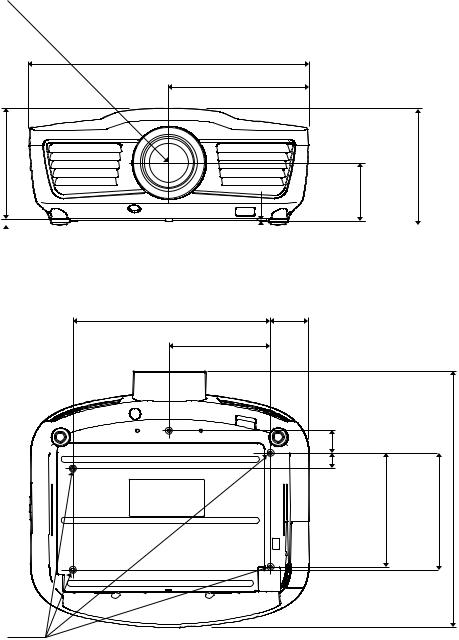
The following illustrations show the dimensions of the projector:
Center of lens
17.3in. (440 mm)
8.7in. (220 mm)
6.9 in. |
7.3 in. |
|
185 mm |
||
174 mm |
||
3.6 in. |
||
|
||
|
92 mm |
|
|
|
|
|
|
0.43 in. |
|
|
0.138 in. |
|
|
|
|
|
|
||
11 mm |
|
12.3 in. |
3.5 mm |
|
2.4 in. |
|
|
||||
|
|
|
|
||
|
|
312 mm |
|
|
60 mm |
6.3 in. (160 mm) |
|
|
15.9 in. |
|
405 mm |
1.38 in. |
|
35 mm |
|
0.98 in. |
|
25 mm |
|
7.1 in. |
7.3 in. |
180 mm |
185 mm |
M4×9mm
Setting Up the Projector 17
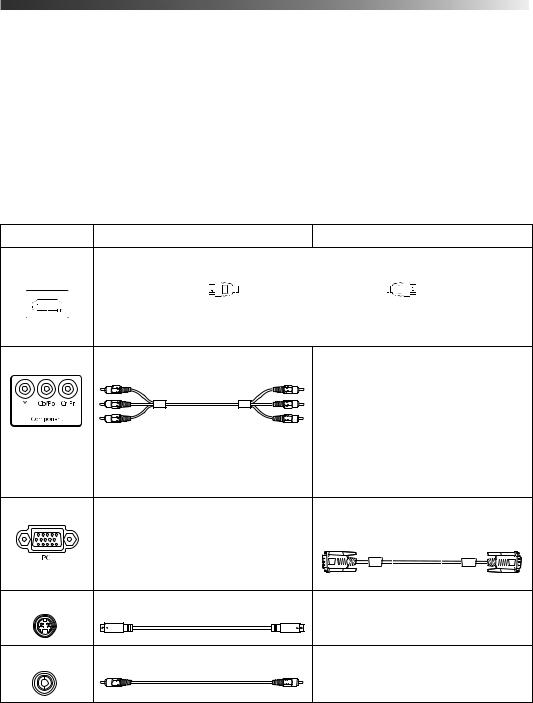
Connecting the Cables
Connecting Video and Computer Equipment
You can connect the projector to many types of video equipment, such as a Blu-ray Disc™/DVD player, digital tuner, cable or satellite box, video game console, camcorder, or digital camera. You can also connect it to a desktop or laptop PC or Apple® Macintosh® system. For details on compatible video formats, see page 71.
You can connect up to six pieces of video equipment at the same time, using any of the commercially available cables shown below:
Port name |
Video equipment connection |
Computer connection |
HDMI 1/ |
Use an HDMI cable: |
|
HDMI 2 |
|
|
|
For a computer with a DVI port, you can also use a commercially available DVI-D |
|
|
to HDMI conversion cable. |
|
Component |
Use a component video cable |
— |
|
(with RCA-style connectors): |
|
|
Connect the cable to the three |
|
|
component video ports. Match |
|
|
corresponding colors between the |
|
|
cable and the ports. |
|
PC |
— |
Use a Mini D-sub, 15-pin monitor cable |
|
|
to connect to a computer RGB |
|
|
(monitor) port: |
S-Video |
Use an S-video cable: |
— |
Video |
Use an RCA video cable: |
— |
18 Setting Up the Projector

For best results, connect your video equipment to the HDMI port, if possible. If your equipment doesn’t support HDMI, connect it to one of the following ports (highest quality listed first): Component (for component video), S-Video, or Video (for composite video).
Connect video equipment to one of these ports
Connect a computer to one of these ports
When you connect an HDMI cable to the projector, it is recommended that you fasten it as shown with one of the included cable clamps.
Making Other Connections
Connect the power cable and other cables described below, depending on how you plan to use the projector.
■ Plug the power cable into the projector and a grounded electrical outlet.
Setting Up the Projector 19

■ The Trigger out port(s) output a 12-volt DC signal when the projector is turned on. This lets a central control system monitor whether the projector is on or off, and can be used to raise or lower your projection screen automatically when the projector is in use. Depending on the setting you select (see page 45), it can also be used to operate an anamorphic lens.
Connect a 3.5-mm mini jack to the port, as shown.
■To use an AV controller with the projector, connect a 9-pin null modem serial cable to the RS-232C port.
Refer to the table of ESC/VP21 command codes on page 74.
Installing Batteries in the Remote Control
The remote control uses two AA manganese or alkaline batteries.
Warning: Keep batteries away from children. If a battery is swallowed, contact your doctor immediately.
1. Release the tab and lift open the cover.
2. Insert two new AA batteries as shown.
3. Insert the tab on the cover and press it down until it clicks into place.
Aim the remote control at the screen, or at the front or back of the projector. Make sure you are within 30 feet of the projector.
If you suspect the batteries are weak, press the  illumination button. If the buttons do not glow,
illumination button. If the buttons do not glow,
replace the batteries.
20 Setting Up the Projector

Turning the Projector On and Off
Turning On the Projector
1. Remove the lens cap.
2. Turn on any connected equipment you plan to use.
3. Turn on the main power switch on the back of the projector.
ON
4. Press the P power button on the projector or the On button on the remote control.
Projector |
Remote control |
|||||||
|
|
|
|
|
|
|
|
|
Note: To prevent children from turning on the projector, you can use the Child Lock feature. See page 29 for details.
If you’ll be using the projector at an altitude above 4900 feet (1500 meters), turn on High Altitude Mode so the fan can properly cool the projector at the high altitude air pressure. See page 46 for details.
The projector takes about 30 seconds to warm up and display an image. If you don’t see a picture, you may need to change the image source as described on page 22.
Setting Up the Projector 21
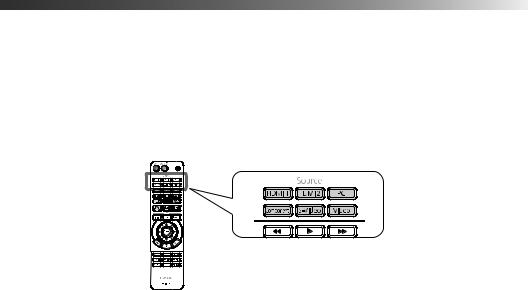
Turning Off the Projector
1.Turn off any equipment connected to the projector.
2.Press the P power button on the projector or the P Standby button on the remote control. When you see a confirmation message, press the button again to turn the projector off.
Caution: Turn off this product when not in use to prolong the life of the projector. Continuous 24-hour-a-day use may reduce the overall life of the product.
Note: You can disable the confirmation message if you only want to press the button once to turn off the projector (see page 43).
3.If you need to move the projector, wait for the P power light to stop flashing, then turn off the projector’s main power switch on the back. You can now unplug the projector.
Caution: Never turn off the main power switch without first turning off the projector and letting it cool as described above, or you could damage it and reduce lamp life.
Selecting the Image Source
The source buttons on the projector and remote control let you switch between images from different pieces of equipment connected to the projector (such as a DVD player, cable or satellite box, or video game console).
Press the Source button on the remote control that corresponds to the port to which your video source is connected.
22 Setting Up the Projector

If you press the  source button on the projector, you see a list of available sources. Press the
source button on the projector, you see a list of available sources. Press the  source button to move through the list and select the desired source.
source button to move through the list and select the desired source.
Note: If an image does not appear, see “Problem Solving” on page 61.
To temporarily turn off the image and darken the screen, press the Blank button on the remote control. Press the Blank button again to return to normal viewing.
Positioning the Image
You can display a test pattern to help adjust the image position by pressing the Pattern button on the remote control. Select Display Position, then press Enter. Press the Esc button to turn off the test pattern. You can also use the Pattern button to isolate colors when displaying color bars (see page 36).
If the image is not centered on the screen, use the lens shift function, as described below, to adjust its position.
■If the image looks like  or
or  , make sure the projector is not tilted up or down. Instead, keep the projector level, then use the lens shift to position the image on the screen.
, make sure the projector is not tilted up or down. Instead, keep the projector level, then use the lens shift to position the image on the screen.
■If the image looks like  or
or  , the projector has been placed off to one side of the screen and angled toward it. Instead, face the projector straight ahead, then use the lens shift to center the image.
, the projector has been placed off to one side of the screen and angled toward it. Instead, face the projector straight ahead, then use the lens shift to center the image.
Setting Up the Projector 23
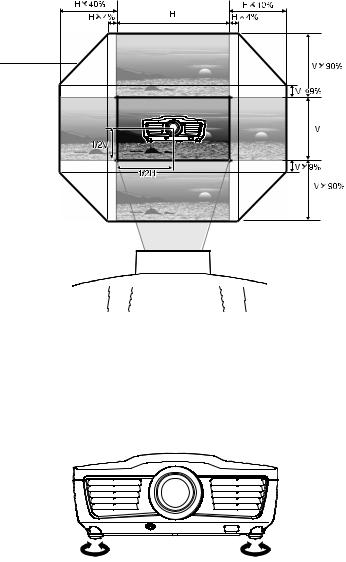
To use the lens shift, press the Lens Shift button on the remote control, then use the
l r u d arrow buttons to adjust the image position. To return the lens to the center, press and hold any arrow button until the lens moves to the center and stops.
Caution: Do not try to move the lens by hand, or you may damage the projector. Always use the lens shift function to change the lens position.
The amount by which you can shift the image is expressed in terms of the horizontal (H) and vertical (V) image size, as shown below:
Maximum lens shift boundary
Note that the image cannot be moved to the maximum distance in both the vertical and horizontal directions at the same time. For example, when the image has been shifted horizontally by the full amount, it can be shifted vertically by only 9 percent of the height of the image.
If the image is centered on the screen but one side is taller than the other, adjust the front feet so that the projector is level.
24 Setting Up the Projector

Making Basic Adjustments
Follow the instructions in this chapter to make basic adjustments to the image shape, size, color, and quality. For further refinements, see “Making Detailed Adjustments” on page 31.
Focusing and Zooming
To focus the image, press the Focus button on the remote control, then use the l and r arrow buttons to adjust the picture.
To adjust the image size, press the Zoom button on the remote control, then use the l and r arrow buttons to reduce or enlarge the picture.
Making Basic Adjustments 25

Choosing the Aspect Ratio
In many cases, video signals are automatically resized to fit on your screen when Auto is selected as the Aspect setting. You may need to change the size of the image (or aspect ratio) for certain image types by pressing the Aspect button on the remote control.
Select one of these settings (some settings may not be available, depending on the input sigal):
■Normal for HDTV (16:9 aspect ratio), computer images, or images recorded at a 4:3 aspect ratio.
HDTV (16:9) image using Normal setting |
4:3 image using Normal setting |
||||
|
|
|
|
|
|
|
|
|
|
|
|
■Full for images recorded in squeeze mode (using horizontal compression). 4:3 images not recorded in squeeze mode are stretched to fit the screen.
■Zoom for images recorded in letterbox format. Fits the image to the screen.
Note: Depending on the image’s aspect ratio, the top and bottom may be hidden from view. Use the Zoom Size option to adjust the image vertically. If subtitles aren’t visible, use Zoom Caption Pos. to reposition the image. See page 43.
■Wide to expand a 4:3 image to 16:9 so it fills the whole screen. This stretches only the
right and left sides of the image; the central part is unchanged.
■Anamorphic Wide to display images that have a 2.40:1 aspect ratio (such as CinemaScope®) when using a commercially available anamorphic lens (available from Epson—see page 10).
Note: If you use this setting without an anamorphic lens, the image fills the screen vertically but not at the correct aspect ratio. Make sure Overscan is set to Off (100%), or the image won’t display correctly (see page 42). If your anamorphic lens has a motorized transport, you can operate it automatically with the Trigger out port (see page 45).
■Horiz. Squeeze to display images that have a 16:9 or 4:3 aspect ratio when you’ve equipped the projector with a fixed anamorphic lens.
26 Making Basic Adjustments
